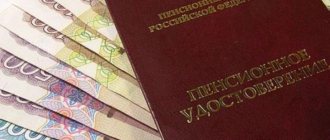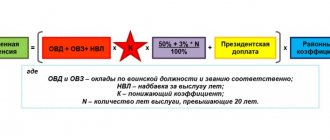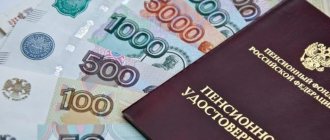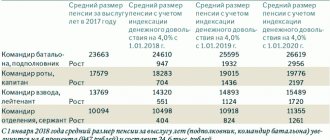Pensions appeared at the beginning of the formation of Soviet power.
- In 1918, the first decree on pensions was issued. This affected the disabled of the Red Army.
- In 1923, a decree on pensions for party leaders appeared. Old revolutionaries.
- In 1924, a decree on pensions, benefits and benefits was issued for military personnel of the Red Army and Navy and their families.
- In 1928 - a decree on pensions for workers in the mining and textile industries.
- Since 1936, pensions have become sectoral. Mainly among officials and workers.
- On June 5, 1941, on the eve of the war, a resolution of the Council of People's Commissars of the USSR was promulgated on providing pensions to military personnel and their families.
History of pensions in the Soviet Union
A very interesting fact is that pensions were provided only to citizens who were not found to have committed bad deeds: that is, the person was not involved or dismissed under the article. Those who had any misconduct had the right to file a petition with the state or could try to “whiten” their reputation by performing their job duties perfectly. Pension payments were not available to monks and citizens who left the country forever.
By the way! There were practically no pension payments after the revolution of 17.

As a rule, pensions were issued to citizens who were not found to have committed any offenses
When the USSR was formed, any royal pensions immediately disappeared. For a very long time, many Soviet workers could not obtain old-age payments, since they were assigned only to certain categories of citizens.
For example, in August 18, pensions were introduced for disabled Red Army soldiers, in 23 – for old Bolsheviks, in 28 – for workers in the mining and textile industries.
By the way! Only in 1930, the Soviet Union adopted the “Regulations on pensions and social insurance benefits,” and seven years later, pension payments were provided to any city workers and employees.

In 1930, the “Regulations on pensions and social insurance benefits” were adopted.
1937: stipend more than pension
Until 1956, the amount of pensions in the USSR was disappointing: for participants in the Civil War and the Red Army who received a disability, only 25 rubles were provided; 45 rubles were paid for the second disability group, and 65 for the first.
A pension was also issued for family members of these disabled people who were unable to work; it ranged from 15 to 45 rubles. Let us note that in 1937, students were given 130 rubles on scholarships. Consequently, former military personnel received negligible amounts.
By the way! The average age of the male population of the Soviet Union for the period 26-27 years was 40.23 years, and the female population - 45.61 years. In 1932, the law established the retirement age: 55 years for women and 60 for men.
This age is still applicable today, although quite a lot of time has passed. To be fair, we point out: at the time of 2017, the average age of the male population increased to 67.5 years, and the female population to 77.4 years. However, starting from 2020, the retirement age is gradually increasing.

Scholarships in the USSR were quite high
The largest pension amount was 300 rubles. Although prices in stores and employee earnings increased, this figure did not change at all. Most citizens of retirement age received approximately 60 rubles. Naturally, it was often impossible to live peacefully on that kind of money without outside help.
Retirement age
It is no secret that in 2020 the retirement age was raised for the first time in many years. On a general basis in the USSR, pensions were assigned to:
• men aged 60 years;
• women aged 55 years.
In this case, it was necessary to have a total work experience of at least 25 and 20 years, respectively. If there was not enough experience, but retirement age had arrived, you could retire and receive payments, provided:
• reaching retirement age while working (that is, a person must be working at the time of reaching retirement age); • having a total work experience of at least 5 years, • working immediately before retirement for at least 3 years, • applying for a pension no later than one month from the date of termination of work.
Pension payments in the 80s
During this period, the number of citizens of retirement age in the USSR increased greatly. Despite this, the government continued to provide them with funds on time, taking into account the level of inflation. The average pension amount in those days was about 67 rubles.
Pension payments in 1985
At this time, due to the impact of inflation and improving living standards, pension payments in the country became maximum, amounting to 72 rubles. Let us note that collective farm participants were paid significantly less money than city residents - an average of 47 rubles.

Over time, pensions increased
Average pension
Over the entire existence of the Soviet Union, the volume of the average pension has undergone significant adjustments. The basis was not only the level of inflation, but also a significant increase in the standard of living of the country's population.
In the early 70s, the average amount of pension payments reached 34 rubles, but after 16 years the number increased to 76.
By the way! In general, the pension in those days was generally similar to the money that citizens of retirement age receive now.
Largest pension
As we have already found out, the largest pension under the Soviet Union was 120 rubles. It was provided to city residents working in the field of intellectual activity: engineers, doctors, teachers. Of course, such money was given out for working a sufficient amount of time.

The highest old-age pension in the USSR was 120 rubles, but there were also various allowances
Pensions in the USSR and now
Typically, residents of our country calmly accept the ideas of their bosses, but the idea of late retirement does not impress them at all. The number of people willing to work into old age is small. This is only 9% of the population. In other words, citizens are not at all inspired by this prospect. And even propaganda from media personalities will not improve the attitude of citizens towards the looming increase in the retirement age.
Like many other things, we inherited the pension system from Joseph Stalin. In the USSR, pension payments for industrial workers (and not all) began to be issued since 1932. At the same time, the retirement age for men was set at 60 years. But life expectancy at that moment did not reach 50. The Soviet Union under Stalin was a fairly young country, so Stalin promised pensions to workers on communist construction projects, showing that collective farms were no longer relevant - there were no pension payments there, and there was not enough money. If you didn’t want to work on a collective farm, you could go to the army, and then to a factory. Let us note that working at the factory, in addition to providing money in old age, promised a significant privilege in the future - reservation from conscription into the army if martial law suddenly came to the country.

Back in the USSR, the retirement age was determined: for men - 60 years, for women - 55
Those who ruled the country after him had to fulfill the promises made by Stalin regarding pensions. Only by 1956 did all workers and employees of the country have a legislatively confirmed right to state support in old age - previously the provision of this money was extremely limited.
Participants in collective farms began to receive help only after 10 years, and their pensions were tiny: from 12 to 20 rubles. An important part of the pension for collective farmers was the money collected from the people themselves. In rare cases, funds from the budget could be allocated. Note that until the age of 71, the right to a pension was granted to men over 65 years of age.

Members of collective farms tended to have lower pensions
The pension payments themselves were not pleasing with their size. However, by the mid-70s, the country's leadership was forced to make a significant political decision. People who participated in the war were retiring - the generation that expected wonderful communism and a generally “rosy future” by the 1980s. The natural question was: how can they survive in old age if there is no support from the state?
By the way! This category of citizens, or rather, a certain part of it, began to be paid pensions similar to the average earnings of 120 rubles.
By 1981, the number of citizens of retirement age was 27 million—that’s 10% of the country’s total population. However, at the moment there are 43 million pensioners in the country, and this figure continues to grow. As a percentage, this is more than a quarter of all residents. Pension Fund expenses are only half compensated by insurance premiums - the other applies to budget transfers. If the retirement age is not raised, the budget will not be able to pay even the small pensions that are currently established - this is what the government believes. But increasing the retirement age will make it possible to continue payments even in small amounts.
Pension systems in the Russian Empire, USSR and Russian Federation
The debate over pensions has stirred up unnecessary social emotions in our society. Indeed, this topic worries everyone or almost everyone. She is not interested only in a fairly narrow stratum of the rich and cunning, who resolved their material issues in troubled times of capital accumulation. Accumulated often not only for themselves, but also, as it seems to them, for their loved ones, for centuries to come.
The issue of pensions, being at its core a pragmatic issue, in a normal social situation not heated by controversy, should be resolved based on the real capabilities of the state.
But for the umpteenth time, such reforms are being carried out according to Western stencils, not in accordance with domestic traditions.
Our reformers, unfortunately, continue to perceive our country in the style of New Year's greetings of 2011. While formally president at the time, Dmitry Medvedev said on air: “Russia is a young country. Let me remind you that she will only turn 20 next year. This is not an age for the state.”
Of course, if the Russian Federation is perceived as a “young country” that is barely a year old, then, as another reformer said, we need to “learn, learn and learn” from everyone, and from the West first of all.
For all normal people, the sun rises in the east, but for our progressives it’s not like that. The sun of all reformation ideas rose, rises and continues to shine on them only from the west. They continue to deny any original creativity in these areas, and any experience of national tradition.
What was it like in the Russian Empire?
Photo: www.globallookpress.com
Pensions in the Russian Empire before the revolution consisted of two parts: state treasury and emeritus funded for non-military personnel; and three-part: state, emerital and paid from the Committee on the Wounded for the military.
It all started with monetary benefits and land grants to crippled soldiers, which were reflected in official documents back in the era of the Moscow State.
Emperor Peter Alekseevich was the first to introduce old-age maintenance, which was recorded in the “Charter of the Russian Naval Fleet” (1720), which determined the pension compensation for naval officers. Army officers began to receive a “pension” only from the middle of the 18th century.
The founder of the pension legislation system can rightfully be considered Emperor Nicholas I, who in 1827 approved the “Charter on Pensions...”. In this Charter, pensions began to be assigned based on the number of years of service.
Since 1869, military personnel were divided into 9 categories, and the size of the pension amounts received depended on the rank and length of service. For 35 years of unblemished service, a full salary was due (an officer's salary for the last five years of service), for 30 - two thirds, for 25 - half and for 20 - one third. These amounts were formed from 2% annual contributions.
Raising the retirement age in Russia – pros and cons
Subsequently, the pension payment system was improved. Since 1912, leaving half the annual allowance, with each subsequent year of service (from 25 to 35 years) they began to add 3% of the pension. Full pension was due after 35 years of service.
It must be added here that service during the war was counted as two years. And in special cases, for example, being in Sevastopol during its siege in the Crimean War, each month was counted as a year, and the defense of Port Arthur was counted as 1 day for 12.
Pilots of the Imperial Army were in a special position: since 1914, those who flew a certain standard of flight duration were counted as seven years of experience. The same increased differentiation applied to service in remote areas of the Empire. Thus, for category I, 2 days were counted as 3, for category II - 3 days for 4, and for category III - 4 for 5.
Peasants. Photo: www.globallookpress.com
Of particular note is the preservation of officer pensions not only for widows, but for the children of deceased or deceased officers. Upon the death of an officer, the widow received half the pension as if her husband had retired. To this half, if there were children, a third of the other half of the pension for each child was added. Likewise, the children of officers, orphans, received one-fourth of the pension until they came of age (sons until the age of 17, and daughters either until marriage or until the age of 21).
In addition to the state treasury, officers, and, importantly, lower ranks and their families received money as wounded through the Alexander Committee for the Wounded. The average payout is also known - 70 rubles.
The third part of pension payments was handled by the so-called emerital (savings) funds organized by the Minister of the Navy since 1863, and by the military since 1895, which were formed from 6% deductions from salary and state co-financing.
The conditions were as follows: it was necessary to serve for at least 25 years and participate in such a cash register for at least 20 years. Then the veteran received half the salary for service from 20 to 25 years, and for 25 or more - the full salary.
Government officials of all departments and classes, teachers, customs officers, doctors, etc. had a similar retirement system. They began receiving pensions in 1764.
The 1896 charter, which existed with minor changes until the revolution, required 35 years of service to receive a full pension, and 25 years of service for half. In the presence of severe incurable diseases, the service life was significantly reduced: for 20 years of service a full pension was given, from 10 to 20 years - two thirds, from 5 to 10 years - one third. In special cases, an enhanced pension was also awarded. Pensions were divided into 9 categories. The first received 1143 rubles. 60 kopecks, and at the lowest ninth - 85 rubles. 80 kopecks. Interestingly, all these categories included university studies and military service. And work in particularly difficult places, for example, in Polish provinces, was considered 5 years as 7.
Cavalry. Photo: www.globallookpress.com
The state pension for employees was also supplemented from the emeritus funds of the ministries. Pensions for both the clergy and zemstvo employees had similar systems.
The pension system of the Empire has evolved, but has not undergone such revolutionary changes and vacillation from side to side as we have seen in recent decades.
It had a strong tendency to expand. In fact, by 1913, all those who today would be called “state employees”, and then those working at “state-owned enterprises,” were covered by the pension system. Engineers, foremen and workers of all state enterprises and railways were included in the pension sphere of the Empire.
The pension system was not built on an age principle. There was no age after which people would retire. The pension and its size depended on the specific years of service, and on its success and integrity. It was understandable to people and stimulated people both to work and to service.
With widespread large families and a pension system, old people in the Russian Empire rarely found themselves in hopeless social situations.
The class approach: pensions in Soviet times
The Bolsheviks, having begun to dispose of the Russian Empire, also famously abolished all tsarist pensions in a revolutionary manner. All the savings of the emerital treasuries and order committees were nationalized and, apparently, used for some more “important” revolutionary needs.
Many broad social declarations were issued: including on November 1, 1917, the Soviet government announced that it was going to take care of providing for the elderly, widows and orphans. But in reality, they started not with them, but with the disabled of the Red Army (1918), then they remembered the old Bolsheviks (1923) - fortunately, there were not so many of them left.
Civil War. Photo: www.globallookpress.com
The rest were transferred to an accident insurance system, somewhat similar to the factory worker insurance system introduced by the Tsarist government in 1912. The state did not participate in this insurance in any way, and the entire financial burden was transferred to legal entities. Insurance premiums ranged from 21% to 28% of the organization's payroll.
It only came to the workers, the beauty and pride of the revolution, in 1928. And even then only for workers in the mining and textile industries. That's when those 60 years for men and 55 years for women emerged as the age limit for retirement.
It is interesting that in 1926-1927 the average survival age in the USSR for men was 40 years, and for women - 45.5. So it was extremely difficult to reach that pension. There is data published by V. Roic on the number of pensioners in the USSR. In 1928 there were 2,700 people, and, for example, in 1932 - less than 48,000. In fact, to retire until 1929 (resolution of the Central Executive Committee and Council of People's Commissars of the USSR dated May 15, 1929 “On provision of social insurance in the event of old age") it was impossible to leave due to old age. Pensions were given only for disability or, as they put it then, for loss of ability to work.
According to this decree, the pension system had a strict class orientation - only urban workers could be pensioners. Another limitation was the list of industries in which pensions were introduced. It covered only a small part of the workers. To receive 50% of previous earnings, men had to have at least 25 years of experience, women - at least 20. In fact, at best, they received 25% of the average salary in the country.
Pensions reached all city workers and employees only in 1937.
THE USSR. 1936 Photo: www.globallookpress.com
There were no significant changes in the pension system in the subsequent years of Stalin's reign. Most pensioners received a very small pension, with a ceiling of 300 rubles (in the 1950s) and an average salary of about 1,200 rubles. Let’s not forget about forced government loans, which the population was often forced to sign up for.
Moreover, this whole “social paradise” - and this must be understood - until 1940 was complemented by the existence of a six-day working week, with five (!) days off per month (6, 12, 18, 24 and 30 of each month) and 12 days of vacation per year (“Rules on regular and additional holidays” (approved by the NKT of the USSR 04/30/1930 N 169).
In 1939, the XVIII Congress of Communists decided for the first time to catch up and surpass the capitalists in production per capita. The party wanted to complete this task in 10-15 years, and the population had to switch to an even more rigid work system.
At the height of friendship with National Socialist Germany, the Decree of the Presidium of the Supreme Soviet of the USSR “On the transition to an eight-hour working day, to a seven-day working week and the prohibition of the unauthorized departure of workers and employees from enterprises and institutions” (1940) was adopted.
This decree increased the working day by one hour at all enterprises. The number of days off per month was reduced from five to four. It was prohibited to leave work without permission, as well as to move from one enterprise or institution to work in another without the permission of the director or boss.
For unauthorized departure from work, workers and employees were put on trial and subjected to imprisonment for a period of 2 to 4 months. For absenteeism without a valid reason for the authorities, the court sentenced to corrective labor for up to 6 months with a deduction of up to 25% of the salary.
Under Khrushchev, in 1956, a new system for workers and employees was introduced. The ratio of wages to pensions in the USSR has always been no more than 25-38%.
N. Khrushchev. Photo: www.globallookpress.com
Rural residents and petty-bourgeois elements according to Marxist ideology were especially disadvantaged on the basis of class. The class approach towards peasants, who were the majority of the population of the USSR, continued until 1964, when the law “On pensions and benefits for members of collective farms” was adopted.
But even after the adoption of this law, the Soviet government did not abandon the class approach to collective farmers. They had to retire not like everyone else, but later: men - at 65, women - at 60. And the size of peasant pensions was several times smaller than that of workers. The minimum pension was set at 12 rubles; in reality there were pensions even lower.
But the Soviet government managed to further reduce this amount, equivalent to several kilograms of doctor’s sausage, by 15% - for a personal plot, if it exceeded 15 acres. The provision was only repealed in 1978.
In terms of retirement age, collective farmers were equalized with city residents, apparently, only in 1971. At the same time, a pension minimum for workers and employees of 45 rubles was introduced.
Against this background, excluding special benefits and other privileges, the personal pension of the Secretary of the CPSU Central Committee was 300 rubles, a candidate member of the Politburo - 400 rubles, and a member of the Politburo - 500 rubles.
So social justice was strictly class-based throughout the Soviet period.
Politburo of the CPSU Central Committee. Photo: www.globallookpress.com
What would be useful to introduce into a modern pension system?
First of all, it would be useful to move away from the age principle. Every person ages differently. Everyone develops their own resource based on the conditions and specifics of work, as well as based on their health. Perhaps the age limit could be left only for those who have not worked at all for some exotic reasons or for those who have not reached the age of work, say, 60 years, and do not intend to continue working.
Why do we cling to age indicators of 55, 60 or 65 years? Who needs it? It would be useful to refer to the imperial experience of labor or service. Let the quality and salary parameters during the years of active work and the length of service itself be the measure of a decrease or increase in pension benefits. This system would be more understandable and people wouldn't get hung up on annoying retirement numbers. There would be no need to discuss them, much less introduce them to public hooting.
Of course, in the length of service system, it would probably be necessary to take into account such parameters as time spent caring for a child, studying, serving in a combat situation, in hard-to-reach areas, in hard work, etc. By adjusting the length of service parameters with these additional indicators.
And secondly, it is necessary to return to the system of emerital (savings) funds, which should, if people voluntarily wish to save for old age, increase the total amount of pension payments.
The Russian state is not 20 or 100 years old, but more than a thousand, and considerable experience has been accumulated even in such a specific area as pensions. Not paying any attention to it is stupid and even explosive.
Pension of deputies from the people
In 1989, the highest authority was people's deputies, holding congresses to clarify important issues relating to the state. The last time this happened was September 5, 1991. This date is symbolic in that the deputies decided to dissolve themselves. Today, most of these deputies have retired. The State Duma raised the problem of the need to increase pensions for this subgroup of people.
By the way! Now the total number of people who were former people's deputies is about 285 people.

People's deputies, according to the government, should receive high pensions
The Ministry of Labor and Social Protection proposes to set the pension amount at 200 thousand rubles. The reason for this proposal is the abolition of personal pension payments for this category of people, on the basis of which deputies from the people and members of their families had the right to decent material security.
Calculation of military pensions in the USSR
The level of pensions for senior command personnel started from 300 rubles per month. At the same time, officers in senior positions were one of the few categories of pensioners in the Soviet Union who had the privilege of continuing to serve without age restrictions.
Which in itself was a significant increase in retirement income.
Despite the variety of pension privileges, including compensation for special working conditions, the average level of pension provision in the USSR still remained quite low relative to pension income in European countries, including being inferior to the European countries of the so-called “socialist camp”. One of the reasons for this situation was imperfect pension legislation. In the Soviet Union, there was no legislative provision for the possibility of indexing pension payments in connection with changes in the external and internal economic situation.
How was military pension calculated in the USSR?
What a difficult job for people who decide to devote their lives to serving the country and its people! Military activity is not only difficult, but also very dangerous. It takes away sleep, health, and sometimes even life. In this regard, the state has taken care of earlier retirement dates for people in extreme professions.
Military pensions are different from other government benefits. Let's try to highlight some features and differences in the article. Who can count on a military pension? A person who served has the right to receive a military pension.
This could be work in the country's armed forces, in the Ministry of Emergency Situations, in the penal system or in drug control agencies.
Employees of these departments are classified as military personnel and, under certain circumstances, may qualify for a special type of pension.
Liveinternetliveinternet
The adopted changes to regulate pension savings in the USSR in the new economic conditions were in effect, however, for a very short time: from January 1, 1990 to January 1, 1991.
As for the general shortcomings of the distribution pension system that developed in the Soviet Union, the most important of them were as follows. Firstly, the lack of a uniform pension strategy with unified rules for assigning pensions.
The multiplicity of options for pension schemes, along with additional social benefits and privileges (regional, sectoral, status and others), gave rise to an opaque and extremely cumbersome system for calculating individual pensions.
Secondly, the selectivity of the action of pension law, which became especially noticeable with the adoption of the law on entrepreneurial activity in the USSR.
Law of the USSR of April 28, 1990 on pensions for military personnel
Pensions in the USSR: Social reforms 1917-1990. The creation of social security bodies of the Soviet period began literally in the first days after the October Revolution.
So, already on October 29 (November 11, new style) 1917, the head of the new government, Vladimir Lenin, signed a decree on the creation of the People's Commissariat of State Charity.
Already on October 30 (November 12), Lenin had a conversation with Alexandra Kollontai, who, after extensive experience in party work at the beginning of the 20th century, was invited to the post of first minister in the Soviet government.
https://www.youtube.com/watch?v=c4d-oPpzt2Y
The choice of candidate for the post of People's Commissar of Charity was not accidental. Already on October 30 (November 12), Lenin had a conversation with Alexandra Kollontai, who, after extensive experience in party work at the beginning of the 20th century, was invited to the post of first minister in the Soviet government. The choice of candidate for the post of People's Commissar of Charity was not accidental.
Pension for military personnel: registration procedure. calculation of a military man's pension
Important There are several types of military pension:
- by length of service;
- on disability;
- due to the loss of a breadwinner.
Let's look at each in a little more detail. Long service pension The most common type of military pension is long service pension. Until recently, only a certain period of service was necessary to obtain it.
Today, the length of service at the time of dismissal must be at least twenty years. Due to the unstable situation in the country, the reorganization of services and departments, and the need for regular activities, it may be impossible to gain full military experience. In such cases, upon dismissal upon reaching the age of 45 years, the total length of service is calculated at 25 years, of which at least half must be in military service.
Pension for military personnel for length of service: calculation rules, allowances and features
Work on social security of military personnel and members of their families is organized and carried out in order to timely and fully satisfy military personnel discharged from military service and members of their families, deceased, killed or missing military personnel and military pensioners with the pensions, benefits and allowances provided by law. compensation, as well as providing these persons with all possible assistance in providing the benefits established for them to meet urgent needs, ensuring an adequate level of their social security. In accordance with the Regulations on military commissariats, approved by the Decree of the President of the Russian Federation of October 1, 1999.
Geo.ru
Attention
As it was in the Russian Empire Historically, not only in Russia, but also in other countries, that initially the social security of soldiers and their families was predominantly in kind, expressed in the provision of land allotments, the provision of shelter in old age, etc. Then, gradually, monetary remuneration comes into first place: starting from the era of Peter I, the payment of cash pensions - the so-called pensions - has been practiced. At the same time, many natural types of allowance are preserved.
In the 18th century Pension in the USSR Maximum criteria for pension payments The maximum indicators for pension payments were 120 rubles. Residents of the city who were engaged in mental work, for example, doctors, teachers, engineers, etc., could count on this amount. In this case, the amount of the pension depended on the amount of the monthly salary.
Calculation of military pension
In the event of death or injury resulting in death, the pension for each dependent will be greater than that where the serviceman died in a situation not related to service. The calculation of a military personnel pension is based on the following standards:
- official salary;
- surcharge for rank;
- length of service bonus.
The size of the military pension is affected by the applied coefficient (0.56). In 2013, it was decided to increase this indicator every year until it becomes equal to one.
The calculation of a military pension is influenced by the level of inflation in the country, which is also taken into account. Formula for self-calculation If you wish, you can independently calculate a military personnel’s pension. To do this, you need to know the formula and values of constant and variable units.
Amount of pension in the Soviet Union (USSR) Residents of a city or province were required to support them: by paying them “entry feed”, that is, cash tax, and fees in kind upon the initial occupation of the voivode position, as well as paying him a tax three times a year;
- thirdly, some cities were given up for ransom to individuals, including from the military. This practice, widespread in the 17th century, was one of the main sources of social tension in society.
It was also practiced to keep retired soldiers in monasteries. The state established standards for the in-kind allowance of each soldier and the monetary payments due to him, and also determined the number of persons assigned to a particular monastery.
Pension provision for military personnel in the first years of Soviet power was regulated by the resolution of the Central Executive Committee of the USSR dated October 29, 1924 “On approval of the Code of Laws on Benefits and Advantages for military personnel of the Workers’ and Peasants’ Red Army and the Workers’ and Peasants’ Red Fleet of the USSR and members of their families.”
Literally on the eve of the Great Patriotic War, on June 5, 1941, the Council of People's Commissars of the USSR adopted a resolution “On pension provision for military personnel and members of their families,” which determined the size of the pension depending on wages and the causes of disability of military personnel.
With the end of the NEP period and the beginning of collectivization in 1929, the standard of living of the working population fell rapidly.
In the pre-war period (before the start of the Great Patriotic War), the minimum standard of living for workers - in terms of the ratio of wages and the cost of the consumer basket - was recorded in 1940.
All about military pensions The average amount of payments to pensioners is just over 11 thousand rubles. This is 40 percent of the salary. Social pension – 7500 rubles. Unlike Soviet times, today there is no such thing as a minimum pension.
It is calculated based on the cost of living in each region. There is also no maximum size.
It all depends on many factors - when a person retires, how long he has worked, what his salary was, and the amount of pension contributions.
Innovation: starting from this year, the maximum pension coefficient will be calculated. This is a kind of assessment of each year of a person’s work.
In general, the Russian pension system has become more flexible when compared with the Soviet one. Possible bonuses and additional payments have increased. In addition, Russian pensions are regularly indexed. Pension in the USSR.
Source: https://lcbg.ru/nachislenie-pensij-voennym-v-sssr/
Pension Law
The main law in the Soviet Union responsible for the problems of crediting pensions is the law “On State Pensions”, dated July 14, 1956. The document discusses the nuances of the maximum retirement age, length of service and average pension, as well as much more.
Most of the data in the bill is no longer relevant, but the reform created in 1956 provided citizens of retirement age with good money at that time. The inflation rate was not taken into account, since the cost of various goods was constantly increasing. So the reform was subject to frequent corrections.
By the way! Even now, the government is going to radically change the pension system, allowing people to independently influence the size of their own pension.

Pension reform in the USSR was regularly improved
Old people are not welcome
Elderly people were respected by Soviet society due to their complex and long life path since the 1930s. Immediately in the years after the revolution, old people - often women - were considered, according to M. Romashova, backward and stuck in everyday life, people not particularly needed by society.
By the way! Historians explain: an old man evoked associations with imminent death. And no one enjoys thinking about death. Once upon a time, youth and old age were not considered something natural, and young people did not think at all about the fact that they themselves would someday be elderly. Nobody respected old age.
As we have already found out, the pension payment system in the Soviet Union took a very long time to come into decent shape. In 1818, on the basis of a decree of the Council of People's Commissars of the RSFSR, social benefits were provided to people who did not have a basic income or a certain share of it due to the loss of the ability to perform labor duties or lack of work. In other words, it was talking about unemployment benefits or a disability pension.

Initially, pensions were quite small
During the 1920s, other groups of people who were entitled to social benefits slowly began to appear. For example, in 21, “elderly and disabled teachers who have merit in public education” could count on an increase in pension payments. Over time, pensions also appeared for military personnel who lost the opportunity to perform official duties during hostilities, and in 29, material support “reached” some categories of employees: workers in the mining, metallurgical and electrical industries, railway and water transport. Here you can come across already known figures: financial support in old age was provided to men from the age of 60, and to women from the age of 55. The work experience had to be 25 and 20 years, respectively.
By the way! Article twelve, “Regulations on pensions and social insurance benefits,” enshrined in a resolution of the Council of People’s Commissars in 1930, had a huge impact on pensions in the Soviet Union. Based on this article, employees of state enterprises had the right to an old-age pension. It is worth noting that, despite the predominance of the agricultural industry in the country at that time, participants in collective farms were not provided with a pension at all. However, in 1935 the situation changed.

You had to have a work experience of 25 years (for men) and 20 years (for women)
How did pension provision happen? To begin with, let's say that at that time there were no pension funds. This was done by a specific company. On collective farms, after discussion, management established a special fund and a mutual aid fund.
It is important to realize that the collective farm budget was mainly intended for what is needed here and now, so often the elderly citizens of the collective farm did not hold this money in their hands. They were paid their pensions in “kind” form: grain, hay, firewood, and the like. This kind of support was not yet considered mandatory. Therefore, on successful collective farms, old people lived well, but on weak ones, their standard of living left much to be desired.
Average monthly wages from 1960 to 2001
This coefficient is used to calculate the amount of the so-called estimated pension - the part of your future pension earned in the period before 2002.
RP = SK * KSZ * 1671 – 450.
It is clear that the larger the value of the KSZ , the larger the size of the estimated pension.
For most citizens, the average salary is ZR
in the period 2000-2001.
recorded in the Pension Fund (PF) and does not require documentary confirmation. Therefore, if to calculate the coefficient of the average monthly salary you chose the period 2000-2001, then the coefficient of the average monthly salary is calculated by dividing your average salary ZR
for this period by
1494.5 - the average salary in the Russian Federation in 2000-2001.
KSZ = ZR / ZP = ZR / 1494.5.
However, if to calculate the coefficient of the average monthly salary of the KSZ it is more profitable for you to use another period of working activity - any 60 months (5 years) in a row until 01/01/2002, then you will need:
- Calculate your average salary for this period - ZR (this can be done using our ( calculator )
- Using the tables below (or a calculator) determine the average salary in the country of the salary for the period of your choice (60 months (5 years) in a row)..
- Calculate the KSZ yourself (or using a calculator .
- When applying for a pension, submit documents to the Pension Fund office confirming your earnings for the selected 60 months.
Average monthly wages established by law
to convert pension rights into estimated pension capital
| Average salaries during the Soviet period from 1960 to 1990 | |||||||
| Year | Wed. salary (rub.) | Year | Wed. salary (rub.) | Year | Wed. salary (rub.) | Year | Wed. salary (rub.) |
| 1960 | 73,1 | 1968 | 110,9 | 1976 | 154,2 | 1984 | 193,2 |
| 1961 | 77,1 | 1969 | 115,6 | 1977 | 159,1 | 1985 | 199,2 |
| 1962 | 80,9 | 1970 | 121,2 | 1978 | 164,4 | 1986 | 206,1 |
| 1963 | 82,4 | 1971 | 125,6 | 1979 | 168,4 | 1987 | 214,4 |
| 1964 | 86 | 1972 | 130,4 | 1980 | 174 | 1988 | 233,2 |
| 1965 | 92,5 | 1973 | 136,2 | 1981 | 178,3 | 1989 | 263 |
| 1966 | 97,2 | 1974 | 143,2 | 1982 | 184 | 1990 | 303 |
| 1967 | 102,5 | 1975 | 148,7 | 1983 | 188,3 | ||
| Average salaries between 1991 and 1997 | |||||||
| Month | Year | ||||||
| 1991 rub | 1992 rub | 1993 thousand roubles | 1994 thousand roubles | 1995 thousand roubles | 1996 thousand roubles | 1997 thousand roubles | |
| January | 308 | 1438 | 15,3 | 134,2 | 302,6 | 654,8 | 812,2 |
| February | 294 | 2004 | 19,1 | 144,7 | 321 | 684,4 | 821,2 |
| March | 337 | 2726 | 23,6 | 164,8 | 361,5 | 745 | 902,9 |
| April | 373 | 3052 | 30,6 | 171,4 | 386,2 | 746,5 | 901,1 |
| May | 438 | 3675 | 37,5 | 183,5 | 429,9 | 779,3 | 919,7 |
| June | 493 | 5067 | 47,4 | 207,5 | 480,6 | 837,2 | 993,2 |
| July | 541 | 5452 | 56 | 221 | 499,5 | 842,8 | 999 |
| August | 548 | 5876 | 65,4 | 232,8 | 520,6 | 831 | 982 |
| September | 613 | 7379 | 80,9 | 253,2 | 564,5 | 848,1 | 1026 |
| October | 703 | 8853 | 93 | 265 | 594,5 | 843,3 | 760 |
| November | 839 | 10576 | 101,5 | 281,6 | 615,7 | 835 | 760 |
| December | 1195 | 16071 | 141,2 | 354,2 | 735,5 | 1017 | 760 |
| Average salaries between 1998 and 2001 | ||||
| Month | Year | |||
| 1998 rub | 1999 rub | 2000 rub | 2001 rub | |
| January | 760 | 923 | 1194 | 1523 |
| February | 760 | 793 | 1324 | 1523 |
| March | 760 | 837 | 1254 | 1523 |
| April | 760 | 851 | 1257 | 1724 |
| May | 760 | 851 | 1257 | 1653 |
| June | 760 | 851 | 1257 | 1635 |
| July | 760 | 969 | 1413 | 1896 |
| August | 760 | 787 | 1411 | 1550 |
| September | 760 | 1180 | 1325 | 1567 |
| October | 760 | 1157 | 1528 | 1671 |
| November | 760 | 1281 | 1457 | 1671 |
| December | 760 | 1086 | 1584 | 1671 |
Note. Pension legislation imposes a restriction on the value of the SSC - the coefficient cannot be more than 1.2 .
Example 1. Let your average salary in 200-2001. was 2500 rubles - salary = 2500 and you did not work in the Far North until 2002. We calculate the coefficient:
Real KSZ = ZR/ZP = 2500 / 1494.5 = 1.67.
Since it exceeds 1.2 and you do not have “northern” benefits, then in further calculations the coefficient will be considered equal to 1.2:
Your KSZ = 1.2.
Example 2. Let your average salary in 2000-2001. was 1000 rubles - salary = 1000. We calculate the coefficient:
KSZ = ZR/ZP = 1000 / 1494.5 = 0.67.
Since it does not exceed 1.2, in further calculations the coefficient will be taken equal to 0.67:
Your KSZ = 0.67.
An exception to the upper limit of the coefficient - 1.2 - was made only for those who worked before 2002 in the regions of the Far North - for them, depending on the regional coefficient, the bar ranges from 1.4 to 1.9 - see article
Online pension calculator (calculate your pension yourself)
Useful articles:
- Algorithm for calculating pensions in 2020 and subsequent years
- Calculators from 45-90 for calculating pensions
- Structure and principles of pension formation
- Pensions. Structure and calculation according to the new rules
- Funded pension - a benefit or a scam?
Interesting Facts
Pensions in the Soviet Union are often described in two terms.
Positive : any citizen of retirement age in the USSR received support in the amount of 100-120 rubles every month.
Negative : citizens of retirement age under the Soviet Union lived very sadly: literally on 15 rubles a month. To be fair, let's say that both of these opinions are fair.

The size of the pension in the USSR is now assessed differently by people
The amount of the pension in those days was related to salary. For example, if a woman worked as a cleaner, then in retirement she will be paid about 80 rubles. An experienced specialist was paid about 130 rubles. The respected Bolshevik had the right to be provided with a personal pension of Union significance, amounting to 300 rubles. If a citizen did not work enough time, he had the right to receive a social pension - 35 rubles. This figure is considered the minimum for the USSR. We can conclude that the average pension amount in the USSR reached approximately one hundred rubles.
Citizens living in villages were provided with pension payments that were 15% less than workers and employees. Thus, the largest amount is 102 rubles, and the smallest is 34. However, village residents had their own privileges over city residents. The first received pension money in full, regardless of the amount of earnings. And for the second, income could not exceed a certain number. If the threshold was exceeded, the pension was reduced by the amount of the difference.
Old-age pensions were issued on a general basis to the male population aged 60 years and over, and to the female population from 55 years old. It was necessary to work for 25 and 20 years, respectively.

Of course, the size of the pension largely depended on the position of the citizen and his work experience
An old-age pension was issued if a person did not work the required time, and also:
- he reached retirement age while performing his job duties;
- he has worked for a total of at least five years;
- before retiring, he worked for at least three years;
- he applied for a pension no later than one month from the date of completion of work. Please note that there are no allowances for such pension payments.
So, the pension payment system in the USSR is in many ways similar to the one that exists now in modern Russia. The amount of payments largely depends on the employee’s length of service, his salary, and for special merits or residence in the Far North, you can receive various allowances and privileges.
Soviet pensions: as it was under Lenin, Stalin, Khrushchev
The pension system existed even under tsarism.
But today we want to tell you how the “fate” of pension payments turned out after the revolution? And how did they build a scheme thanks to which Soviet pensioners could live carefree, and even help their children and grandchildren? In the early years they helped the disabled and orphans
After the revolution, the Soviet government immediately began to implement Lenin's insurance program, outlined at the VI All-Russian Conference of the RSDLP. Of course, pension insurance at that time was no longer a novelty in the country, but in Tsarist Russia workers were not paid pensions for old age and disability caused by general illness. Their families received nothing even in the event of loss of breadwinners.
The Soviet government decided to fill all these gaps. Already on November 1, 1917, a government announcement on social insurance was published. In it, the state for the first time took upon itself the financial support of the elderly, disabled, widows and orphans. At the same time, due to the difficult economic situation, the young country was not yet able to introduce old-age pensions. There was a civil war, and first of all it was necessary to provide pensions to disabled Red Army soldiers.
Under Stalin, old people received additional living expenses from their relatives
When peace came and life in the country improved somewhat, in 1928 old-age pensions were introduced for workers and employees. At the same time, the lowest retirement age in the world was established: for men - 60 years, for women - 55. At the same time, the authorities improved pension provision for disabled people and families who have lost their breadwinner.
However, pensions remained very low; for example, in 1937, a disabled person of the 1st group received 65 rubles, a disabled person of the 2nd group received 45 rubles, and a disabled person of the 3rd group received 25 rubles. For comparison: a student scholarship in 1937 was 130 rubles. per month and it was impossible to live on it without additional income
The old-age pension, judging by the sources that have reached us, was only slightly larger. Even in the last years of Stalin’s life (in the 1950s), their “ceiling” was 300 rubles. with an average salary of about 1200 rubles. In other words, the maximum pension was only 25% of the average salary. It is clear that it was impossible for elderly people to live on that kind of money without the support of their relatives.
Khrushchev gave pensions to collective farmers
But, finally, Stalin’s times went into the past and Nikita Khrushchev began to lead the Soviet state. Since then, the communist pension system began to flourish. In 1956, a pension reform was carried out in the USSR, which fully met the interests of workers, and the amount of payments for city residents - workers and employees - was significantly increased. In addition, pensions were introduced for the first time for collective farmers, although they were calculated according to a separate system and were lower than those of other workers.
This system remained almost unchanged until the collapse of the USSR. Its postulates were simple, understandable and accessible to every citizen of the country of the Soviets:
- retirement age is 60 years for men and 55 years for women;
- the length of service required to grant a pension is 25 years for men and 20 years for women;
- pension amount - half the employee’s average salary for the last two or any five years of working life;
- The pension “ceiling” is 120 rubles per month.
It is also important to note that workers were allowed to work even after retirement, while their pensions were retained. But it was possible to occupy a specialist’s chair and maintain a pension only in areas where there was a shortage of personnel, for example, in medicine.
If we talk about the size of pensions, at first glance they may seem small. However, we must remember that in those days the state subsidized low prices for bread, milk, utilities, public transport and movie tickets. Medical services were also provided free of charge. Since, in addition, pensioners did not have to spend money on children and acquiring durable items (furniture, televisions and refrigerators served in Soviet families for decades), they often turned out to be better off than adult children. And, of course, they helped their descendants, which had a beneficial effect on their moral well-being, and therefore on their health.
On a note
There were also privileged pensioners in the USSR. They received a so-called personal pension of various significance - district, city, regional, republican, all-union. Its size was determined by the government. Based on some sources of those years, experts claim that the “ceiling” of such pensions, even for senior officials of the USSR, did not exceed 300 rubles.
Anna Voitko










